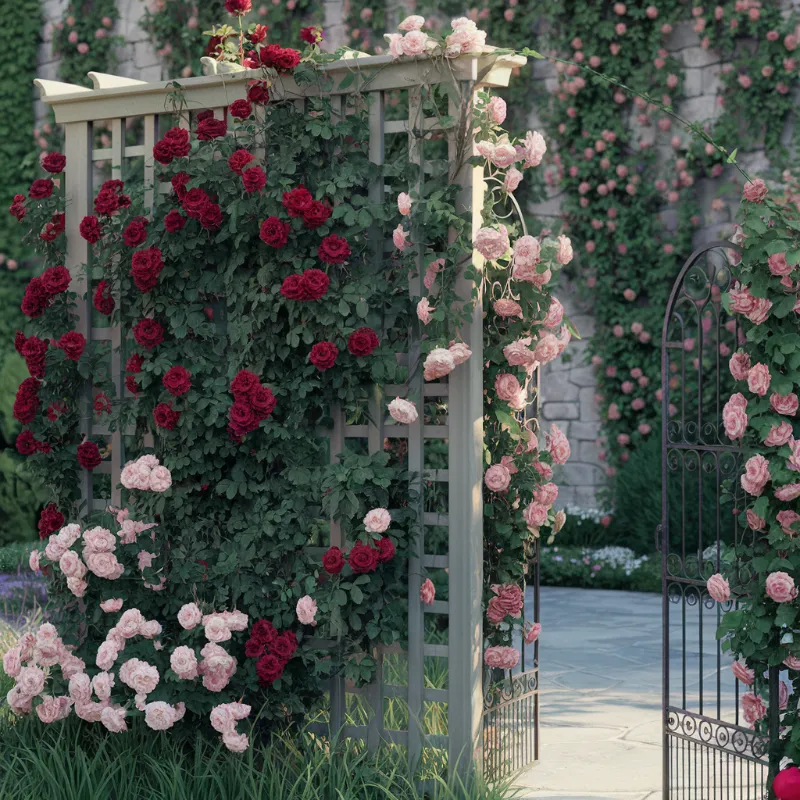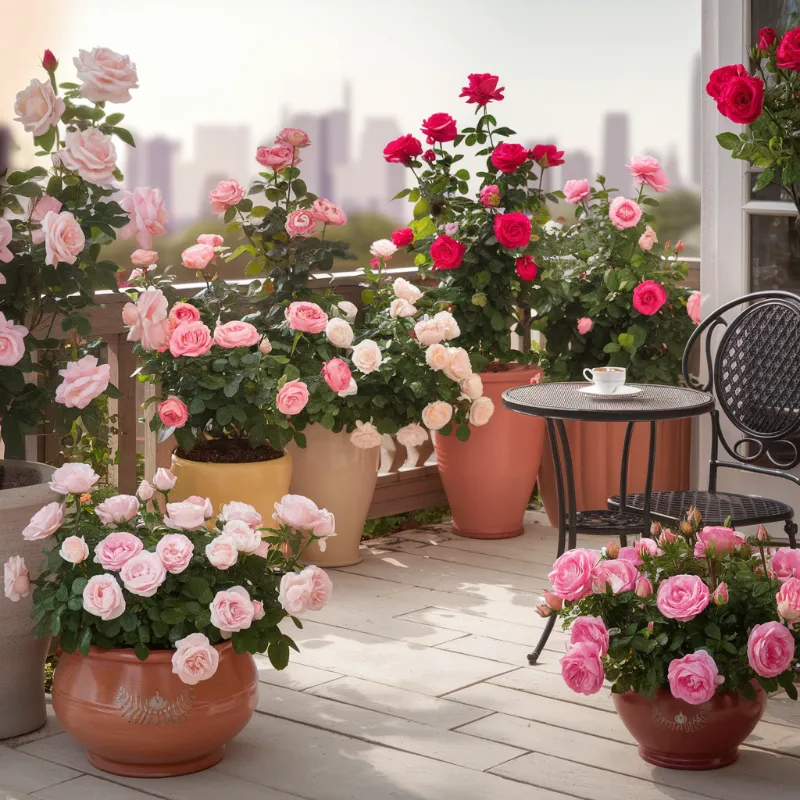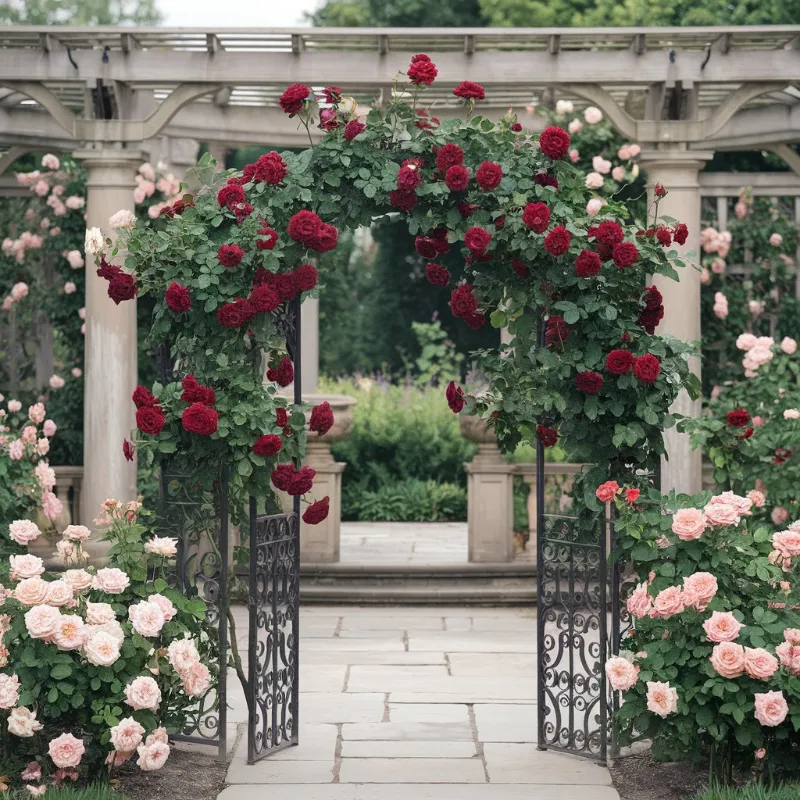Imagine Sarah’s backyard before it was transformed. It was dull and uninviting. But then, it became a stunning rose garden that everyone loved. Sarah knew the secret to making her yard special with rose landscaping ideas.
Roses are more than just flowers. They can turn your outdoor spaces into works of art. With shrubs, ramblers, and climbers, roses offer endless ways to beautify your yard.
Studies show that roses can boost your home’s look by 5-15%. Now, 62% of garden lovers choose roses for their beauty and lasting charm.
Roses are versatile. They can make privacy screens or vertical gardens. Shrub roses are 3-5 feet tall, while climbers can reach 10-15 feet, adding beauty to pergolas and arbors.
Whether you’re an experienced gardener or new to landscape design, these seven rose ideas will inspire you. They’ll help you create outdoor spaces that are elegant, colorful, and timeless.
Table of Contents
Understanding Different Types of Roses for Landscaping
Choosing the right rose varieties can turn your garden into a stunning work of art. The Rosa genus has over 300 species. This means there are many rose bushes for landscaping to fit any style.
Roses come in different types, each with its own special features. These features make them perfect for various garden designs:
- Hybrid Tea Roses: Large, dramatic blooms with 30-50 petals
- Floribunda Roses: Compact, disease-resistant bushes
- Shrub Roses: Versatile and low-maintenance
- Climbing Roses: Perfect for vertical garden elements
Climbing Roses vs. Shrub Roses
Climbing and shrub roses are quite different. Climbing roses, like the Altissimo, can grow 8-15 feet tall. They need support from trellises or walls. On the other hand, shrub roses, such as Knockout varieties, are smaller. They usually grow 2-4 feet tall.
Popular Rose Varieties for Gardens
| Rose Variety | Height | USDA Zone | Characteristics |
|---|---|---|---|
| Knockout Roses | 2-4 feet | 4-9 | Disease-resistant, multiple colors |
| Easy Going Floribunda | 2-6 feet | 5-10 | Continuous blooming |
| Home Run Red | 24-36 inches | 4-10 | Compact shrub variety |
Color Selection and Blooming Patterns
Modern roses come in a wide range of colors and patterns. Unlike old garden roses, which bloom once, modern ones bloom all season. You can find roses in deep reds to soft pastels. This lets gardeners pick roses that match their outdoor colors.
“Choose roses that not only look beautiful but thrive in your specific climate and garden conditions.” – Rose Cultivation Expert
By pruning regularly and caring for your roses, your garden will stay vibrant and healthy all season.
Creating Dramatic Vertical Gardens with Climbing Roses

Vertical gardens turn simple spaces into amazing green areas. Climbing roses are perfect for gardeners wanting to make a big impact with little ground. These plants make walls, fences, and buildings come alive with beauty.
“A well-designed rose trellis can turn a plain surface into a breathtaking botanical masterpiece.”
Rose trellis ideas vary from classic wooden to modern metal designs. It’s important to pick a support that fits your garden’s look and the rose type.
- Choose trellises between 6-8 feet tall for optimal rose growth
- Position support structures against south-facing walls for maximum sunlight
- Space climbing roses 2-3 feet apart for dense, vibrant coverage
Climbing roses do more than just look good. They:
- Create living privacy screens
- Transform bare walls into colorful backdrops
- Add vertical interest to outdoor spaces
| Rose Variety | Height | Sunlight Requirement |
|---|---|---|
| Don Juan Climbing Rose | 10-12 feet | Full Sun |
| Eden Climber Rose | 8-10 feet | Full Sun to Partial Shade |
| Fragrant Cloud Climber | 6-8 feet | Full Sun |
For a thriving vertical rose garden, use strong mounting and good soil. Regular pruning keeps shape and controls growth.
Designing Rose Container Gardens for Patios and Terraces

Container gardens are a great way to add beauty to patios and terraces. They turn these areas into lively flower displays. Using portable containers for rose gardens is perfect for small spaces or adding height to outdoor areas.
Choosing the right container is key for growing roses. Not all roses do well in containers.
Container Size and Soil Requirements
The perfect container for roses has certain features:
- Recommended pot size: 8 to 15 gallons
- Must have drainage holes to prevent root rot
- Soil mixture: Two-thirds potting mix, one-third compost
Choose miniature roses, polyanthas, and small shrub varieties for small spaces. These roses do great in containers.
Arrangement Tips for Maximum Impact
To make your rose container garden stand out, follow these tips:
- Position containers to receive 5-6 hours of full sunlight daily
- Space containers 2-3 feet apart for proper air circulation
- Consider mixing rose varieties with complementary heights
Maintenance Guidelines for Potted Roses
For your container roses to thrive, you need to care for them regularly:
- Water daily during hot summer months
- Use liquid rose fertilizer every 4-6 weeks
- Repot every 2-3 years to maintain plant health
“Container roses are not just plants, they’re portable gardens that bring life and color to any outdoor space.”
By using these tips, you can make your patio or terrace a beautiful flower garden.
Landscape Uses for a Rose: Essential Planning Tips
Roses can turn simple outdoor spaces into beautiful gardens. A well-planned rose garden can make your property look elegant. They can be used in many ways, not just in flower beds.
- Line driveways and walkways for impressive curb appeal
- Create focal points in garden borders
- Develop privacy screens using rose hedges
- Accent architectural features like fences and pergolas
To plan a rose garden, know what they need. Roses need at least 6 hours of sunlight and good drainage. Different types of roses can do different things in your garden:
| Rose Type | Landscape Use | Height Range |
|---|---|---|
| Climbing Roses | Vertical garden elements | 6-12 feet |
| Shrub Roses | Border plantings | 3-5 feet |
| Drift Roses | Ground cover | 2-3 feet |
*”Roses are the true queens of the garden, capable of transforming any landscape into a breathtaking masterpiece.”*
Choosing the right colors for your rose garden is important. Pick colors that match your garden and bloom all season. Knockout Roses come in red, pink, and yellow and are easy to care for.
Incorporating Roses in Garden Borders and Edges
Rose border plantings turn simple gardens into stunning landscapes. To design beautiful rose landscaping, you need a plan and creativity. By layering and mixing roses with other plants, you can create eye-catching displays.
Choosing the right spot for your roses is key. It adds depth and interest to your garden. Here are some tips for designing a great rose border:
- Plant roses in groups of 2-3 for maximum visual impact
- Use height variations to create layered borders
- Mix rose colors for dynamic garden aesthetics
Layering Techniques with Different Heights
Understanding plant heights is important for rose borders. Taller shrub roses go at the back, while shorter ones are better up front. This way, each rose gets enough sun and adds to the garden’s look.
Companion Plants for Rose Borders
Choosing the right plants to go with your roses makes your border better. Here are some good choices:
- Hellebores for winter interest
- Pulmonarias to provide textural contrast
- Silvery-leaved plants to highlight rose colors
- Perennials like sedums for autumn color
When planning your rose landscaping, don’t forget to leave enough space between plants. Aim for 3-5 feet apart. This helps prevent disease and promotes healthy growth.
“A well-designed rose border is like a living painting, continuously evolving with the seasons.” – Garden Design Expert
Building Beautiful Rose Archways and Pergolas

Rose trellis ideas can turn simple gardens into magical places. Building archways and pergolas with roses needs careful planning. These structures add beauty and make the most of your rose collection.
- Choose sturdy materials like galvanized metal or treated wood
- Select climbing roses that complement your garden’s aesthetic
- Plan for proper spacing and support structures
Experts say certain techniques are key for beautiful rose archways:
- Plant two identical rose varieties on opposite sides for visual symmetry
- Ensure 50 cm planting distance from the scaffold
- Select roses with strong climbing habits
“A well-designed rose archway can transform your garden into a romantic retreat” – Ian Limmer, Classic Roses Nursery Manager
For archways, choose climbing roses that grow up to 3.5 metres tall. ‘Sympathie’ and ‘Gloire de Dijon’ bloom from June to September.
| Rose Variety | Height | Flowering Period |
|---|---|---|
| Sympathie | 3.5 metres | June-September |
| Gloire de Dijon | 2.5 metres | June with autumn repeat |
| Perennial Blue | 3 metres | Multiple blooming cycles |
Pro tip: Metal archways are easier to maintain and last longer than wood. With the right care, your rose archway will be a stunning part of your garden.
Frequently Asked Questions
What are 10 uses of roses?
Gardening & Landscaping – Adds beauty, fragrance, and structure to gardens.
Cut Flowers & Bouquets – A classic for floral arrangements and gifts.
Perfume & Fragrance – Used in perfumes, essential oils, and scented products.
Skincare & Beauty – Rose water and rose oil help hydrate and soothe skin.
Culinary Uses – Rose petals and rose hips are used in teas, jams, and desserts.
Medicinal Benefits – Known for anti-inflammatory and antioxidant properties.
Dried Flower Crafts – Used in potpourri, wreaths, and home decor.
Symbolism & Celebrations – Represents love, friendship, and remembrance.
Aromatherapy – Helps with relaxation and stress relief.
Natural Dye – Rose petals can be used to make fabric or food coloring.
What are roses commonly used for?
Roses are most commonly used for decoration, gifts, and fragrance. They’re popular in weddings, bouquets, and home gardens. They’re also used in skincare, perfumes, and teas.
What are the ornamental uses of roses?
Roses enhance gardens, parks, and landscapes with their color and fragrance. They can be grown in flower beds, climbing over trellises, as hedges, or in containers on patios. Their variety in size and shape makes them perfect for almost any garden design.
What can rose leaves be used for?
Rose leaves can be used in herbal teas, natural skincare, and composting. Some people use them in DIY beauty treatments or as a mild herbal remedy for soothing skin. They also add nutrients to garden soil when composted.
What are the uses of roses in landscaping?
Borders & Hedges – Creates natural fences and property lines.
Climbing Roses – Covers walls, trellises, and pergolas beautifully.
Ground Cover – Some varieties spread well to fill in garden spaces.
Focal Points – Adds elegance and charm to yards and gardens.
Companion Planting – Pairs well with lavender, alliums, and other perennials.
What are 5 facts about roses?
Roses are ancient – Fossils show they’ve been around for over 35 million years!
Edible petals – Certain varieties are safe to eat and are used in jams and teas.
Different meanings by color – Red symbolizes love, yellow for friendship, and white for purity.
Largest rose bush – The world’s biggest rose bush in Arizona covers over 9,000 square feet.
National flower of the U.S. – Declared in 1986 as a symbol of love and beauty.

